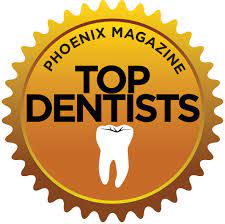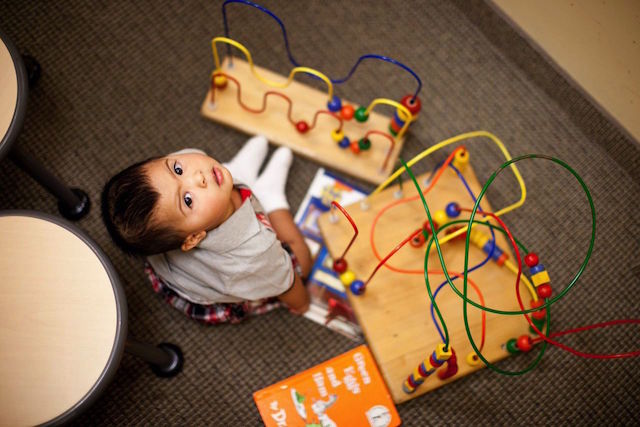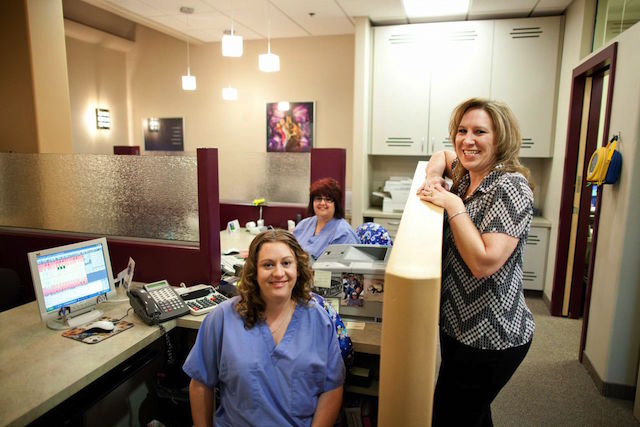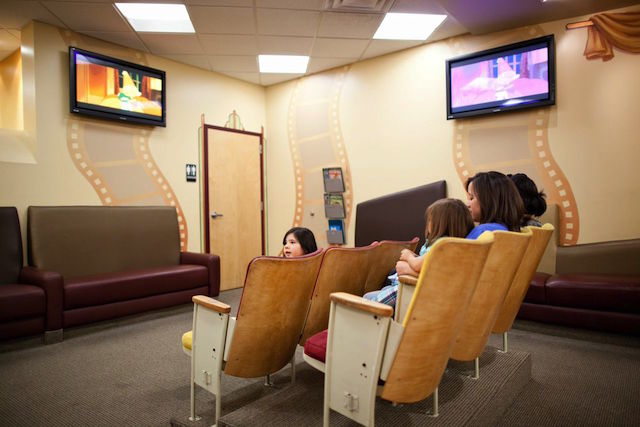About Teeth
Throughout your life, you will have two sets of teeth: primary (baby) teeth and secondary (permanent) teeth.
The primary teeth generally begin to erupt at around 6 months of age. This is just an average, as some babies are born with teeth while others do not have teeth until after their 1st birthday. All 20 baby teeth are usually in place by age 3.
Kids are usually very excited to discover their 1st loose tooth! The front baby teeth, or incisors, usually begin to loosen between ages 5 – 7. The permanent teeth will begin to grow in around age 6. Again, this is an average.
We have seen some kids as young as age 4 and as old as 8 with their first permanent tooth.
With the exception of the wisdom teeth, permanent teeth will continue to erupt until between ages 12 and 14.
The total number of permanent teeth is 32, though few people have room for all 32 teeth. This is why wisdom teeth are usually removed.
Your front teeth are called incisors. The sharp “fang-like” teeth are called cuspids (or canines). The next side teeth are referred to as pre-molars or bicuspids, and the back teeth are molars. Primary (baby) teeth play a very important role in your child’s dental health and aid in the eruption of the permanent teeth.
They also help children speak clearly and chew naturally. Your permanent teeth are the ones you keep for life. It is vital that both primary and permanent teeth are brushed and flossed regularly and that periodic check-ups by a dentist are followed.
Early Dental Care
While your baby is teething, it is important to monitor the teeth for signs of baby bottle decay. Examine the teeth, especially on the inside or the tongue side, every two weeks for dull spots (whiter than the tooth surface) or lines. A bottle containing anything other than water and left in an infant’s mouth while sleeping can cause decay.
This happens because sugar in the liquid mixes with bacteria in dental plaque, forming acids that attack the tooth enamel. Each time a child drinks liquids containing sugar, acids attack the teeth for about 20 minutes. When awake, saliva carries away the liquid. During sleep, the saliva flow significantly decreases and liquids pool around the child’s teeth for long periods, covering the teeth in acids.
Our office is dedicated to fighting baby bottle tooth decay. Regular cleaning of your baby’s teeth is the best way to prevent the onset and progression of baby bottle tooth decay.
Infant’s New Teeth
The primary, or “baby,” teeth play a crucial role in dental development. Without them, a child cannot chew food properly and has difficulty speaking clearly. Primary teeth are vital to development of the jaws and for guiding the permanent (secondary) teeth into place when they replace the primary teeth beginning around age 6.
Since primary teeth guide the permanent teeth into place, infants with missing primary teeth or infants who prematurely lose primary teeth may require a space maintainer, a device used to hold the natural space open.
Without a space maintainer, the teeth can tilt toward the empty space and cause permanent teeth to come in crooked or to get impacted.
Missing teeth should always be mentioned to your family dentist. The way your child cares for his/her primary teeth plays a critical role in how he/she treats the permanent teeth. Children and adults are equally susceptible to plaque and gum problems—hence, the need for regular care and dental checkups.
Care of Your Child’s First Teeth
Prior to the eruption of the first tooth, you may begin with brushing your baby’s gums. You can use a washcloth or a finger brush. This helps get them used to you working in their mouth. We recommend that daily brushing begin as soon as the child’s first tooth erupts with an appropriate sized soft bristle toothbrush and a tiny smear of fluoride toothpaste (or “grain of rice” size).
After age 2, begin using a “pea size” amount of fluoride toothpaste. Begin flossing as soon as you see any teeth that contact. At approximately age 8 to 10, children should be able to brush their own teeth twice a day, though we still recommend supervision. At about age 10 they should be able to brush their own teeth, but we still recommend that you make sure they are doing a thorough job.
However, each child is different. Your dentist can help you determine whether the child has the skill level to brush properly.
Proper brushing removes plaque from the inner, outer and chewing surfaces. When teaching children to brush, place toothbrush at a 45-degree angle, start along the gumline with a soft bristle brush in a gentle circular motion. Brush the outer surfaces of each tooth, upper and lower. Repeat the same method on the inside surfaces and chewing surfaces of all the teeth. Finish by brushing the tongue to help freshen breath and remove bacteria. Also don’t forget to floss, especially in any area where the teeth are touching.
Why Primary Teeth are Important
Primary teeth are important for several reasons. Foremost, good teeth allow a child to eat and maintain good nutrition. Healthy teeth allow for clear pronunciation and speech habits. The self-image that healthy teeth give a child is immeasurable. Primary teeth also guide eruption of the permanent teeth.
Good Diet and Healthy Teeth
The teeth, bones and soft tissue of the mouth require a healthy, well-balanced diet. A variety of foods from the five food groups helps minimize (and avoid) cavities and other dental problems. Encourage your children to eat healthy foods like vegetables, low-fat yogurt and cheeses, which promote strong teeth. Limit snacks high in starch and sugars such as chips, crackers and fruit snacks.
Infant Tooth Eruption
A child’s teeth actually start forming before birth. As early as 4 months of age, the primary or “baby” teeth push through the gums—the lower central incisors are first, then the upper central incisors. The remainder of the 20 primary teeth typically erupt by age 3, but the place and order varies.
Permanent teeth begin eruption around age 6, starting with the first molars and lower central incisors. This process continues until around age 21. Adults have 28 secondary (permanent) teeth—32 including the third molars (wisdom teeth).
Browse through our FAQs to learn more about dental care.
A toothbrush with soft bristles and a small head, especially one designed for infants, is the best choice for infants. Brushing at least twice a day, in the morning and at bedtime, will remove plaque bacteria that can lead to decay.
Baby bottle tooth decay is a pattern of rapid decay associated with prolonged nursing. It happens when a child goes to sleep while breast-feeding and/or bottle-feeding. During sleep, the flow of saliva is reduced and the natural self-cleansing action of the mouth is diminished. Avoid nursing children to sleep or putting anything other than water in their bedtime bottle. Encourage your child to drink from a cup as they approach their first birthday. He/she should be weaned from the bottle at 12-14 months of age.
Thumb and pacifier sucking habits that go on for a long period of time can create crowded, crooked teeth or bite problems. If they are still sucking their thumbs or fingers when the permanent teeth arrive, a mouth appliance may be recommended by your pediatric dentist. Most children stop these habits on their own.
Sealants are clear or white plastic applied to the teeth to help prevent cavities. Sealants fill in the grooved and pitted surfaces of the teeth, which are hard to clean, and shut out food particles that could get caught, causing cavities. Fast and comfortable to apply, sealants can effectively protect teeth for many years. They are meant to help prevent cavities, but do not eliminate the possibility of getting cavities. You still need to brush and floss regularly.
Due to the increasing levels of tooth decay seen in young children, the guidelines on the use of fluoridated toothpaste have changed. According to the Center of Disease Control, tooth decay is now one of the most common chronic diseases of childhood and 42% of children ages 2 to 11 have had cavities.
The current recommendation is to begin brushing with a tiny smear of fluoride toothpaste (“grain of rice” size) as soon as the first tooth erupts. After age 2, begin using a “pea size” amount of fluoride toothpaste. Parents should supervise brushing and make sure the child uses no more than the recommended amount of toothpaste. Children should spit out and not swallow excess toothpaste after brushing. Properly dosing the toothpaste will help minimize the amount accidentally swallowed by a young child who cannot yet spit.
To comfort your child, rinse his/her mouth with warm salt water and apply a cold compress or ice wrapped in a cloth on your child’s face if it is swollen. Do not put heat or aspirin on the sore area, but you may give the child acetaminophen or ibuprofen for pain. See us as soon as possible.
Fluoride has been shown to dramatically decrease a person’s chances of getting cavities by making teeth stronger. Fluoride in the drinking water is the best and easiest way to get it. Your child may not be getting enough fluoride internally through water if you live in a community where the water district does not fluoridate the water, or if your child drinks bottled water without fluoride, or if your home has a water treatment system such as reverse osmosis. In these cases, your pediatric dentist may prescribe fluoride supplements, or you may choose to purchase fluoridated bottled water from companies such as Arrowhead, Culligan or Sparkletts.
With contemporary safeguards, such as lead aprons and high-speed film, the amount of radiation received in a dental X-ray examination is extremely small. Even though there is very little risk, pediatric dentists are particularly careful to minimize the exposure of child patients to radiation. In fact, dental X-rays represent a far smaller risk than an undetected and untreated dental problem.
A mouth guard should be a top priority on your child’s list of sports equipment. Athletic mouth protectors, or mouth guards, are made of soft plastic and fit comfortably to the shape of the upper teeth. They protect a child’s teeth, lips, cheeks and gums from sports-related injuries. Any mouth guard works better than no mouth guard, but a custom-fitted mouth guard fitted by our doctor is your child’s best protection against sports-related injuries.
At about 6 months, the two lower front teeth (central incisors) will erupt, followed shortly by the two upper central incisors. The remainder of the baby teeth appear during the next 18 to 24 months but not necessarily in an orderly sequence from front to back. At 2 to 3 years, all of these 20 primary teeth should be present.
First of all, remain calm. If possible, find the tooth and hold it by the crown rather than the root. Replace the tooth in the socket and hold it there with clean gauze or a washcloth. If you can’t put the tooth back in the socket, try to keep it moist. Place the tooth in a clean container with (in order of preference); “Save a Tooth” kit, egg white, milk, saliva, or water. Take your child and the container immediately to the pediatric dentist. The faster you act, the better your chances of saving the tooth.
Sore gums when teeth erupt are part of the normal eruption process. We recommend following the American Academy of Pediatrics guidelines for teething, which are to give the child a chilled – not frozen – teething ring or gently rub or massage the child’s gums with a finger instead of using benzocaine (over the counter teething gel) to relieve the symptoms.
Usually, the space will close in the next few years as the other front teeth erupt. We can determine whether there is cause for concern.
Primary, or “baby,” teeth are important for many reasons. Not only do they help children speak clearly and chew naturally, they also aid in forming a path that permanent teeth can follow when they are ready to erupt. Some of them are necessary until a child is 12 years old or longer. Pain, infection of the gums and jaws, impairment of general health and premature loss of teeth are just a few of the problems that can happen when baby teeth are neglected. Also, because tooth decay is really an infection and will spread, decay on baby teeth can cause decay on permanent teeth. Proper care of baby teeth is instrumental in enhancing the health of the your child.
Four things are necessary for cavities to form — a tooth, bacteria, sugars or other carbohydrates and time. Dental plaque is a thin, sticky, colorless deposit of bacteria that constantly forms on everyone’s teeth. When you eat, the sugars in your food cause the bacteria in plaque to produce acids that attack the tooth enamel. With time and repeated acid attacks, the enamel breaks down and a cavity forms.








